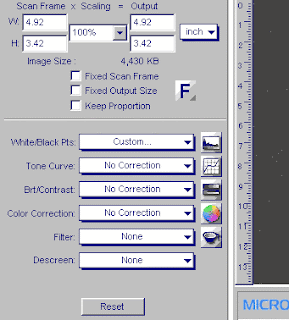
I came across this article by Wayne Fulton. Here are some portions of it:
For those who have not worked with a scanner before, here is a very basic introduction to get started, a brief overview of how it works, how you would actually "use" a scanner.
The flatbed scanner is very much like a copy machine, to the extent that it has a glass plate under a lid, and a moving light that scans across under it. Except that scanners can do great color too, and have more controls possible. And like a copy machine, a flatbed scanner allows you to scan photos, paper documents, books, magazines, large maps, or even 3-dimensional objects (those that don't have a lot of depth, coins for example), etc. It scans very much like a copy machine. But instead of creating another piece of paper like a copy machine does, we instead create an image in memory, which we can do with as we please. We have acquired a digital image, and we can show it on the screen, or write a file and email it, or print it, anything we wish.
We must use software to operate the scanner. Some scanner software can operate by itself, and some cannot. Most image editor programs (like for example Adobe PhotoDeluxe or JASC Paint Shop Pro or Ulead PhotoImpact, etc) have a menu at File - Acquire or File - Import or File - Scanner that you use to scan an image. Sometimes there is a toolbar Scanner icon too. This menu starts the scanner's software, called a TWAIN driver. A fancy word, it is really just another program, but TWAIN is a software standard that all the scanner manufacturers agree to use, intended so that all image programs can operate all scanners. It wasn't always that way, not so long ago you could use only the one image program that came with the scanner. Today you have your choice of any.
TWAIN is often said to be an acronym for Technology Without An Interesting Name (humor), but the FAQ at the www.twain.org organization says it is not an acronym for anything. They say it instead comes from Rudyard Kipling's line "East is East, and West is West, and never the twain shall meet" (The Ballad of East and West, 1889).
The TWAIN driver itself is simply the software provided by the scanner manufacturer to operate the scanner (the user interface), and it is also the interface between the graphics program and the scanner hardware. Twain refers to that separation, now photo editors dont have to know how to operate scanners. The Twain driver will always have another name too, Microtek calls theirs ScanWizard, Umax has two, VistaScan and MagicScan, and HP had a version called DeskScan, and the current is called PrecisionScan. The TWAIN driver comes with the scanner, and knows how to operate this one brand of scanner hardware. Each scanner manufacturer provides their own TWAIN driver for their hardware. You can use any image program, but you typically must use the provided TWAIN driver.
From our human viewpoint, the TWAIN driver ordinarily has the controls that we use to specify the scan; we set the mode (Color or B&W or Line art), we set 100 dpi or 200 dpi resolution, we set the area on the flatbed glass that we wish to scan, and there are controls to help correct the tonal quality and color balance of the scanned image. After the scan completes, the TWAIN driver transfers the image into the image program memory. That is, the new image just appears back in the image program. Then you can tweak the image more, or print it, or save it to a disk file.
The scanner would be used like this:
Start the image program (probably furnished with the scanner, but it can be any, PhotoImpact, iPhoto Express, Photo Deluxe, Photoshop, Paint Shop Pro, etc).
Select the FILE - ACQUIRE menu, or often there is a toolbar button for it. The newer PhotoImpact version calls it FILE - SCANNER. Some software calls it FILE - IMPORT instead, same thing, it is just to keep you on your toes.
Here is a look at a few samples of menus of various popular image programs that shows the Acquire/Import menu used, and how to find it.
Usually there is also a submenu called SELECT SOURCE where you select your TWAIN driver (called TWAIN32 now). You might have two scanners and you will see both of them there. You must make the scanner selection the first time, but only the first time, until it changes. Then subsequentially, you select Acquire again, and Select Image, and the scanner's TWAIN driver will start and appear.
Microtek ScanWizard looks like this, and others are similar in that there are Preview and Scan buttons, and a Preview view of the glass bed.

The first step is the Preview button. When you press the Preview button (or Overview in this case), you get a quick overview scan of entire scanner bed, or as much of its length as you have previously selected (at the Preferences menu). The Preview is a quick low-resolution scan, and that image of the scanner bed appears in the Preview Window. The units along the top and left edge are inches. This is a 3.5 x 5 inch photo shown on the 14 inch bed of this flatbed. Often there are magnification tools, but the final scan is the important view.
To describe the position of the subject on the glass bed to the scanner, you use the mouse to mark a rectangle on the image of the bed, describing the area you want to scan (that's the dashed line shown). You can mark the entire photo area, or can crop the image to be scanned, by marking only a part of it, or perhaps just a 1-inch square area from it. The Scan button will then scan only the area that you have marked with the mouse.
TYPE is shown selecting the Color Mode, see below for Type. You specify the Scanning resolution here too. The 300 dpi shown creates a large image, but you specify whatever you need for your purpose, normally 75 to 300 dpi is common, but purposes do vary (2400 dpi is used to enlarge film - forget all about using 2400 dpi to scan photo prints). Scanning resolution is specified in dpi or ppi (both terms same exact same meaning, Dots Per Inch means Pixels Per Inch).
This resolution number determines the number of samples (pixels) taken from the photo, and therefore the size of the image you will get, like 800x600 or 300x200 pixels. If you scan 6 inches at 100 dpi, you create 6x100 = 600 pixels. This is covered in the Video Resolution Basics section. You can change the units from Inch to Pixels or Cm to see the final image size in pixels or cm.
The Settings screen above shows that we selected 4.92 x 3.42 inches on the photo on the flatbed glass (the red dashed line box shown). At 300 dpi, this will create an image size of 1476x1026 pixels (this size can be shown if units are switched from inches to pixels above). This size image will consume 4.4 MB of memory (also shown).
If we wanted to scan say 4.5 x 3.0 inches instead, we could simply overtype the size numbers here to get it, or we could remark with the mouse. The resolution multiplied by the size of the marked area determines the image size in pixels (see the Video Resolution Basics section). We can change the displayed units from inches to pixels, to see and predict the image size in pixels on video screens.
There are many controls you can use to improve the image, but for now, I'm trying not to confuse things with details. The additional controls provide a way to get even better scans. In ScanWizard, the tiny button at the right end of the lower toolbar reveals a large RESET button that sets all the defaults, to achieve a known starting point for the scan.
Then you set the TYPE of scan (above). Scanner modes offer the following choices to get image types illustrated by these 50 dpi scans of a small photograph.
To continue - You press the Scan button and the scanner will scan. It takes 15 to 60 seconds perhaps, depending, and then the image will automatically appear back in the original image program, the same as if you had opened an image file. You have now "acquired" an image.
You can modify this image in the image programs if desired, lighten it, darken it, crop it, resize it, change its color balance, touch up small areas, edit it drastically, apply various filters like sharpening filters or descreen filters, etc, etc. Or with some TWAIN drivers, you can do all these things as you scan. Often you need to do nothing more if you got it right in the driver. And, of course, you can always discard this image, make a small change, and see the next try in a minute or so. It's not at all unusual to scan an image a couple of times before getting it exactly right. It depends on the purpose and how critical it might be, and if you keep getting better ideas.
But the beauty of a flatbed scanner is that the photo lies motionless on the scanner bed all this time, it doesn't move, and you don't have to keep marking the crop area for every scan. Nothing changes except the settings that you change, so you simply tweak the control, and hit the Scan button again. Nothing to it.
When the image is as you want it, then you can either print it or write it to a disk file, or both. You would use the FILE - SAVE AS menu to specify a file format like TIF or JPG, and a file name. Then you have an image that you can put on a web site or email to someone.
 Édouard Belin is the inventor in 1907 of a phototelegraphic apparatus called the Bélinographe, a system able to send remote photographs, via telephone and telegraphic networks. Since 1914, a photograph of report is transmitted by telephotograph.
Édouard Belin is the inventor in 1907 of a phototelegraphic apparatus called the Bélinographe, a system able to send remote photographs, via telephone and telegraphic networks. Since 1914, a photograph of report is transmitted by telephotograph. The first image scanner developed for use with a computer, was a drum scanner. It was built in 1957 at the US National Bureau of Standards by a team led by Russell A. Kirsch. The first image ever scanned on this machine was a 5 cm square photograph of Kirsch's then-three-month-old son, Walden. The black and white image had a resolution of 176 pixels on a side.
The first image scanner developed for use with a computer, was a drum scanner. It was built in 1957 at the US National Bureau of Standards by a team led by Russell A. Kirsch. The first image ever scanned on this machine was a 5 cm square photograph of Kirsch's then-three-month-old son, Walden. The black and white image had a resolution of 176 pixels on a side.





